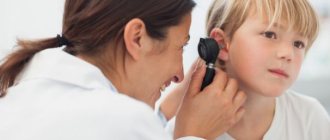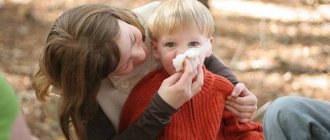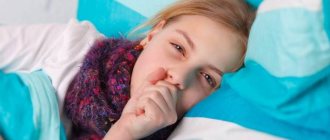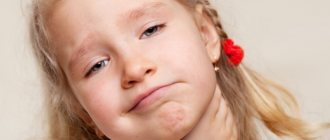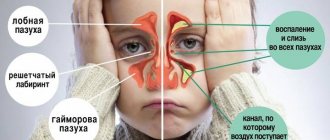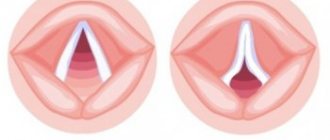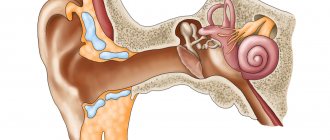Colds and respiratory diseases are not uncommon for any parent. Therefore, most of them know in advance how to treat their children. But if you plan to treat children at home, then you need to be very careful. Inflammation that has not completely resolved can cause complications, one of which may be frontal sinusitis. Frontitis is a special inflammatory reaction that covers all the walls of the frontal sinus and leads to numerous purulent accumulations, its main symptom. However, when it appears, this disease manifests itself quite clearly in children, which is why it is not difficult for doctors to identify and treat it before it is too late.
What are the causes of inflammation?
Causes of frontal sinusitis in children
Young children under 5 years old cannot get frontal sinusitis due to physiological characteristics. And this is due to the structure of the sinus, which in children develops only by the age of 5-7 years, and before that the structure of their nose differs from that of an adult. For the appearance of inflammation in the frontal sinus, good reasons are needed, which are often diseases such as rhinitis. The fact is that if a runny nose is not treated, then sooner or later some of the mucus, which includes a large number of different microorganisms, can get into the paranasal sinuses, which will provoke inflammation. Namely, this is the main reason for the narrowing of the passage, as a result of which other manifestations of frontal sinusitis begin to develop. Due to the warmth and sufficient oxygen, the sinus has almost ideal conditions so that microorganisms trapped there can develop freely. And this despite the fact that inflammation is caused not only by bacteria, but also by various specific viruses and types of fungi. There may be several causes for the disease, but the most common among patients are:
- Weakened or insufficient functioning of the immune system. This point is also supported by statistical data, according to which the symptoms of frontal sinusitis in children manifest themselves in the most painful ones.
- An allergic reaction that causes the airways to narrow even more.
- Various damage to the septum, and, of course, popular among children, foreign objects stuck in the nose, blocking the airways.
- Neoplasms in the nasal cavities, most often polyps in children.
- Dental diseases of varying severity, including caries.
- Anatomical features of a person, whether it is a congenital curvature of the nasal septum, or acquired as a result of injuries, various deformations of the skull.
Chronic frontal sinusitis appears in children in cases where the treatment of the disease in its acute form has not been completed. Because of this, the remains of pus and microorganisms again and again become the cause of the disease. What is most unpleasant is that chronic frontal sinusitis cannot be cured without surgery.
Sinuses
How is frontal sinusitis treated?
Frontal sinusitis is curable, but complex therapy is needed.
Antibacterial therapy
Since the disease is most often caused by bacteria, in case of frontal sinusitis, especially if it is accompanied by high body temperature, children are prescribed antibiotics:
- penicillins,
- cephalosporins,
- macrolides,
- fluoroquinolones.
Antibacterial therapy lasts 7–14 days.
Antiviral therapy
If frontal sinusitis occurs after the flu, then antiviral drugs are prescribed:
- Remantadine,
- Tamiflu,
- Zanamivir,
- Interferon,
- Amizon,
- Arbidol,
- Ribomunyl.
Preference is given to medications that can be instilled into the nasal cavity. They are more effective than tablets and even injections, as they act directly on the affected area.
Elimination of obstruction of the nasal canal
But before administering the drug, it is necessary to remove the obstruction of the nasofrontal canal and restore nasal breathing. For this:
- Rinse your nose. Children are most often recommended to rinse their nose with a solution of sea salt (9 g per 1 liter of water). If the exudate is too thick, the washing liquid is made from soda and iodine. For 1 tsp. sodium bicarbonate requires 1 liter of water, 20 drops of iodine.
- In severe cases, especially with chronic frontal sinusitis, drainage of the frontal sinus is indicated. To do this, trephine puncture (puncture of the frontal sinus) is performed, often under general anesthesia. Wash the sinus with furatsilin, a solution of antibiotics. A drainage tube is installed, through which the sinus is then washed 2-3 times a day for 5–7 days.
- To reduce the release of exudate, sprays with vasoconstrictor drops are prescribed. They are not recommended to be taken for more than 7 days.
Trepanopuncture and frontal drainage are performed extremely rarely in children, only in very advanced cases..
Additional drugs
To begin with, they try to cure frontal sinusitis with the help of complex conservative treatment. Therefore, in addition to prescribing antibiotics, antivirals, and clearing the sinuses of exudate, be sure to prescribe:
- analgesics,
- antipyretics,
- anti-inflammatory.
Nurofen and Ibuprom are most often recommended for children. These drugs not only relieve fever and relieve pain, but also have an anti-inflammatory effect. In addition, they are not corticosteroid drugs, which are not recommended for the treatment of children with purulent, bacterial frontal sinusitis.
Antiallergic drugs must be prescribed:
- Eden,
- Loratadine.
They are necessary not only if an allergic origin of the disease is suspected. Often medications, especially antibiotics, can cause an allergic reaction.
How to determine that a child has frontal sinusitis?
Children of school age will be able to clearly describe each of their sensations during illness, which allows doctors to make a diagnosis more accurately. All that remains for parents is to be attentive to every complaint of their baby, and at the first need to show him to a specialist. However, with preschoolers it’s a little more difficult, because you shouldn’t expect a clear explanation of the sensations, so it’s important to note changes in the children’s well-being. But at any age, the symptoms and treatment of frontal sinusitis are similar, so among the symptoms the following should be noted:
- Severe and stabbing pain in the areas of the forehead and inner eye, radiating from the same inflammation. If you tilt your head, the pain may increase or decrease.
- Severely blocked nasal passages. It can manifest itself at night in the form of quite strong wheezing, as well as severe lack of air in young children.
- Runny nose, and the mucus that flows from the nose does not have to be green. With frontal sinusitis, its color can vary from light and thin to a viscous and yellowish substance. It all depends only on the amount of pus contained in it.
- Serious disturbances in the olfactory function of the body, if the child is small, then the easiest way to check this is with fairly strong odors.
- Cough in the morning, often wet, but can also be dry.
- Constantly watery eyes and severe sensitivity to light.
If it is not possible to ask the child about syndromes or find out in some other way whether he is sick, then only a visual assessment of the condition remains. Here it is worth noting such factors as very pale skin and swelling of the eyelids, as well as swelling above the eyebrow, the latter is not necessarily necessary for frontal sinusitis, but indicates an excessive amount of accumulated pus. Inflammatory processes occurring in the sinus also affect the child’s behavior. So he can: refuse to eat, be capricious too much, or, on the contrary, become extremely apathetic for a long period of time.
Inflammation of the sinuses with frontal sinusitis
What symptoms clearly manifest themselves in chronic frontal sinusitis?
When the form of the disease changes from acute to chronic, most of the symptoms weaken, but complete disappearance is not observed even after weeks and months. However, new symptoms appear, including a nagging headache, repeated several times a day, and nasal discharge with a characteristic unpleasant appearance and smell that can be sharply repulsive. Also, severe snoring, which occurs at night, becomes an attribute of people with chronic sinusitis for the rest of their lives. Also, the chronic form manifests itself in a much larger amount of mucous discharge in the morning and throughout the day. At the same time, the child may begin in the morning to cough up a large amount of sputum that accumulates during the night. The inflammation is not pronounced, and accordingly does not lead to an increase in temperature or other obvious external signs, however, the child’s general well-being seriously deteriorates, and general health problems appear.
How is the treatment process for frontal sinusitis going?
If the diagnosis has been confirmed, then treatment of frontal sinusitis in children begins with medications. After all, first of all, it is necessary to eliminate the ongoing inflammation at the root so that it does not spread further. In addition to this, it is also necessary to restore the previously occurring outflows of mucous secretions in the paranasal sinus, and for this it is important to remove swelling from the mucous layers. Since it is necessary to achieve a whole group of improvements, then a wide variety of medications must be used:
- Thus, they may prescribe special vasoconstrictor drops, which are intended to reduce swelling of the mucous membranes and thereby make breathing much easier. Also, the treatment of frontal sinusitis in children requires this kind of drops due to the fact that they facilitate the release of mucus. But they also have a certain limitation, so these drops cannot be used for more than five days, provided that they are instilled 1-2 times a day. Otherwise, with prolonged use, addiction may occur, causing the nose to simply forget how to breathe freely without them. Since here we are dealing with childhood frontal sinusitis, Sanorin and Vibrocil are most often used.
- Antibiotics are also used, but in cases where inflammation is caused by bacteria. So, this is easy to determine if you take a swab from the nose, and also look at the mucus, which must necessarily be mixed with pus. Children, of course, take antibiotics in tablets and a strict course as ordered by the doctor, but in especially severe cases injections may be required. As a supplement, special sprays are sometimes prescribed that contain the same antibiotics; examples include Isofra and Bioparox.
- When the acute phase of the disease begins, antiallergic drugs are used, such as Suprastin, Diazolin and Claritin. Drugs in this category can seriously improve a child’s sleep pattern, as well as relieve swelling and ease his breathing.
- If you notice an elevated temperature, around 38 degrees, then it is important to take antipyretic tablets, like Nurofen. If the child has a special tendency to convulsions, then antipyretics can be given at an even lower temperature. Among other things, these remedies can effectively relieve headaches that bother children. Thus, they generally facilitate the process of treatment and recovery, which has a beneficial effect on the child himself.
Treatment of frontal sinusitis in children at home
as an additional way to influence the inflammatory process and reduce the manifestation of symptoms. The sequence of actions is previously discussed with the attending physician.
The following procedures will help significantly alleviate the patient’s condition:
- massaging biological points . This action helps reduce pain and drain muconasal secretions. Movements should be soft, rotational, with gradually increasing pressure. Impact points are shown in the photo;
- inhalation procedures . To treat children, it is more rational to use a nebulizer, which avoids burns to the mucous membrane and effectively sprays medicinal substances in a dispersed manner (without heating). An alternative method is to inhale steam over a water bath. Bay leaves, medicinal herbs, garlic and Zvezdochka can be used as medicinal products The duration of the procedure varies from 7-15 minutes . The daily norm is 3 procedures . The optimal temperature of the liquid is 60°C.
The effect on the massaged area varies from 3 to 5 minutes. Duration of massage - 15 minutes
Important! Inhalations are permissible provided that the body temperature is normal!



